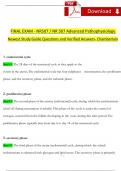FINAL EXAM - NR507 / NR 507 Advanced Pathophysiology
Newest Study Guide Questions and Verified Answers- Chamberlain
1. endometrial cycle
Ans>> The 28 days of the menstrual cycle as they apply to the
events in the uterus. The endometrial cycle has four subphases menstruation, the proliferativ
phase, and the secretory phase, and the ischemic phase .
2. proliferative phase
Ans>> The second phase of the uterine (endometrial) cycle, during which the endometrium
(shed off during menstration is rebuilt). This phase of the cycle is under the control of
estrogen, secreted from the follicle developing in the ovary during this time period. The
proliferative phase typically lasts from day 6 to day 14 of the menstrual cycle.
3. secretory phase
Ans>> The third phase of the uterin (endometrial) cycle, during which the rebuilt
endometrium is enhanced with glycogen and lipid stores. The secretory phase is primarily
,under the controll of progestone and estrogen (secreted from the copus luteum during this
time period), adn typically lasts from day 15 to day 28 of the menstrual cycle.
4. ischemic phase
Ans>> Approximately 3 days before menstruation to onset of men- struation. due to the
decreased production of estrogen or progesterone and the endometrium becomes blood
starved
5. menstrual cycle
Ans>> Cycle during which an egg develops and is released from an ovary and the uterus is
prepared to receive a fertilized egg.
6. Ovulation
Ans>> The process of releasing a mature ovum into the fallopian tube each month
7. uterine prolapse
Ans>> the condition in which the uterus slides from its normal position in the pelvic cavity
and sags into the vagina
,8. risk factors for uterine prolapse
Ans>> menopause, pregnancy, coughing, consti- pation, obesity, pelvic floor trauma,
vaginal birth, hysterectomy, connective tissue disorders, spina bifida
9. uterine prolapse treatment
Ans>> - kegel exercises
- estrogen therapy
- maintaining a healthy bmi, preventing constipation, treating chronic cough
- pessary
- surgical option s last resort
10. polycystic ovarian syndrome
Ans>> defined as two of the following three features
- irregular ovulation
-elevated adrogens (testosterone)
- and the appearance of polycystic ovaries on ultrasound
11. differentials for pcos
, Ans>> - thyroid dysfunction
- hyperprolactinemia
- congenital adrenal hyperplasia
12. Characteristics associated with PCOS
Ans>> -metabolic dysfunction
- dyslipidemia
,- insulin resistance
- obesity
13. polycystic ovarian syndrome treatment
Ans>> (1) diagnosis and education;
(2) lifestyle change - loss of 10% of body weight may help;
(3) birth control pills help with some symptoms;
(4) diabetes medications & dietary treatment may slowly normalize physiology (lower sugar,
lower insulin, fewer androgens)
14. testicular cancer
Ans>> malignant tumor in one or both testicles commonly develop- ing from the germ cells
that produce sperm; classified in two groups according to growth potential
15. conditions that increase risk of testicular cancer
Ans>> - being a man between the ages of 20-45
- cryptochidism (undescended testicle)
- family history
- previous testicle cancer
- white men are more likely
16. symptoms of breast cancer
Ans>> change in the shape or appearance of your breasts, skin or nipple changes such as
,dimpling of the skin, Squeeze each nipple gently to identify any discharge, chest pain (mets to
the lung)
17. signs of premenstrual dysphoric disorder
Ans>> physical - breast tenderness, abdominal bloating, headache and swelling of
extremities
emotional - depression anger, irritability and fatigue resolve with
menstruation
18. causes of dysfunctional uterine bleeding
Ans>> can be due to structural (polyp, malignancies and hyperplasia) or non structural
causes (coagulopathy, ovulatory dysfuction, endometrial
19. treatment for abnormal uterine bleeding
Ans>> - NSAIDS
(reduce prostaglandin, causes vasoconstriction, and decreased menstrual bleed- ing)
- Oral contraceptives
- Depo provera
- Levonorgestrel intrauterine device
20. Pathophysiology of prostate cancer
Ans>> - more than 90% of all cancer arising from the *prostate are adenocarcinomas
(glandular tissue)*
,- tumor becomes clinically relevant when local invasion or distant metastasis
-- starts with genetic mutation of luminal or basal cell
- RF are old age, obesity and high fat low fiber diet
21. Treatment of prostate cancer
Ans>> chemotherapy, radiation, hormones, prostatec- tomy
, 22. HPV and the development of cervical cancer
Ans>> HPV is a necessary precursor
to development of cervical dysplasia which is a necessary step for the cell changes leading to
cervical cancer
- multiple sex partners, smoking, long history of oral contraceptive use use of vaginal douches
and immunocompromised are at higher risk as well
23. body's process for adapting to high hormone levels
Ans>> negative feedback system occurs telling the endocrine system to stop secreting
hormones because there are enough hormones in the bloodstream
24. Cushing's syndrome
Ans>> - a condition caused by prolonged exposure to high levels of cortisol
- adrenal glands secrete cortisol
- severe muscle bone and skin breakdown
- elevated blood glucose levels and high insulin levels
- central obesity
- amplify catecholamines on blood vessels and causes high blood pressure
- inhibit gonadotropin releasing homone messing up ovarian and testicle function
- dampens inflammatory and immune response
- caused by medications (steroids)




